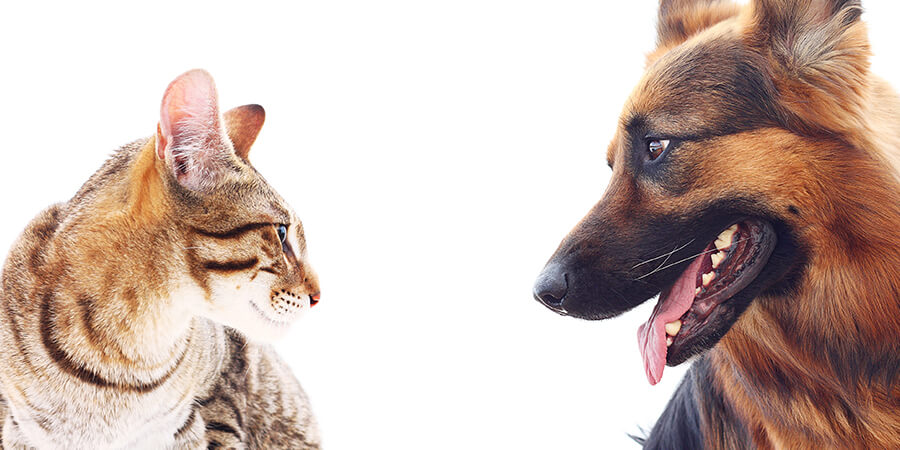Introducing a dog to a cat can take a couple of weeks to a few months, depending on your pets. Monitor their reactions and progress at their own pace.
Consider consulting a positive reinforcement-based trainer for assistance.

Credit: www.worldsbestcatlitter.com
Preparing For The Introduction
Introducing a dog to a cat requires careful preparation. Consider their breeds, gather supplies, keep them apart initially, start a scent exchange, let them hear each other, and have playtime and treats in the same place. Progress at a pace comfortable for both pets.
Introducing a dog to a cat can be a delicate process that requires careful preparation and consideration. Before bringing your new furry family members together, there are a few important steps you should take. By following these guidelines, you can help ensure a smooth and successful introduction.Consider Their Breeds
One essential factor to consider when introducing a dog to a cat is their respective breeds. Some dog breeds have a higher prey drive or are more inclined to chase small animals, which can make them less suitable for cohabitating with cats. On the other hand, certain dog breeds are known to be more cat-friendly and have a better chance of getting along with feline companions. Before introducing them, research your dog and cat’s breeds to understand their typical behavior and compatibility.Gather Your Supplies
To facilitate a safe and stress-free introduction, gather the necessary supplies beforehand. You will need a baby gate or pet barrier to physically separate the dog and cat while allowing them to see and smell each other. Additionally, ensure you have separate food and water bowls, litter boxes, and comfortable resting areas for both pets. Having these supplies ready will help you create a positive environment for the introduction process.Here is a table to summarize the essential supplies needed:| Supplies | Quantity |
|---|---|
| Baby gate or pet barrier | 1 |
| Food and water bowls | 2 sets |
| Litter boxes | 1 for the cat |
| Comfortable resting areas | 1 for each pet |
Keep Them Apart At The Beginning
To ensure a gradual and controlled introduction, it is crucial to keep the dog and cat separated at the beginning. Set up a safe and comfortable space for each pet, ideally in separate rooms. This will allow them to become familiar with their new surroundings and establish a sense of security before they officially meet each other.By following these steps and taking the time to prepare, you can lay the foundation for a successful introduction between your dog and cat. Remember that every pet is unique, and the introduction process may take time. Patience and careful observation of their behaviors are key to ensuring a harmonious relationship between your furry companions.
Credit: sitmeanssit.com
Taking Baby Steps
Introducing a dog to a cat requires patience and careful steps. Start by keeping them apart initially, then gradually introduce scent exchange, allowing them to hear each other, and eventually have supervised playtime in the same area. Monitor their reactions and progress at their own pace for a successful introduction.
Keeping Them Apart At The Beginning
When introducing a dog to a cat, it’s important to start with baby steps to ensure a smooth transition. One of the first steps is keeping them apart at the beginning. This allows both the dog and the cat to become familiar with each other’s scents and presence without feeling overwhelmed or threatened.To keep them apart, make sure they have separate areas in the house. You can use baby gates or closed doors to create physical barriers between them. This will prevent any direct contact that might lead to a negative reaction.Starting A Scent Exchange
A great way to introduce a dog and a cat is by starting a scent exchange. This helps them become accustomed to each other’s smells and creates a sense of familiarity.To do this, take a cloth or towel and gently rub it on your dog, focusing on areas with strong scents such as their neck or back. Then, place the cloth near your cat’s resting area or food bowl. Similarly, rub a cloth on your cat and introduce the scent to your dog’s area. This gradual scent exchange will help them get used to each other’s presence.Letting Them Hear Each Other
Aside from scents, it’s important for the dog and the cat to hear each other’s noises. This helps them become aware of each other’s presence and adjusts their reactions accordingly.You can start by allowing them to be in separate rooms but with a closed door in between. This will allow them to hear each other’s sounds without the pressure of direct contact. Gradually increase their exposure to each other’s noises by leaving the door slightly open or using a baby gate. This way, they can get used to the sounds the other makes and adapt their reactions over time. Remember, introducing a dog to a cat requires patience and a gradual approach. Taking baby steps, such as keeping them apart, starting a scent exchange, and letting them hear each other, can set a positive foundation for their future interactions. By allowing them to adjust at their own pace, you increase the likelihood of a harmonious relationship between your furry friends.Gradual Introductions And Interaction
Introducing a dog to a cat should be done gradually and with caution. Start with scent exchange and let them hear each other before allowing face-to-face interaction. Monitor their reactions and progress at a pace that makes them comfortable. Professional trainers can provide assistance during the process if needed.
Having Playtime And Treats In The Same Place
During the gradual introduction of a dog to a cat, it’s essential to create positive associations between the two animals. One effective way to do this is by having playtime and treats in the same place. This allows the dog and cat to engage in enjoyable activities together while associating those activities with positive experiences. Choose a neutral area where both the dog and cat can feel comfortable, and have plenty of toys and treats on hand. Encourage them to interact with each other through play, and reward them with treats for calm and friendly behavior. This will help in building a positive relationship and reducing any tensions that may arise during the introduction process.
Progressing Through Barriers
Another important aspect of introducing a dog to a cat gradually is progressing through barriers. By starting with physical barriers, such as baby gates or separate rooms, you can allow both animals to get used to each other’s scent and presence without direct physical contact. Over time, as they become more comfortable, you can gradually remove barriers and increase their interactions. This gradual progression allows them to adjust to each other’s presence at their own pace, reducing the likelihood of fear or aggression. It is crucial to monitor their reactions closely and make adjustments accordingly to ensure a smooth and safe introduction.
Monitoring Animals’ Reactions
Throughout the introduction process, it is essential to closely monitor the animals’ reactions to each other. Pay attention to their body language, vocalizations, and overall behavior. Signs of fear, anxiety, or aggression should be addressed immediately by separating the animals and providing them with a calm and safe space. It’s also crucial to observe their interactions during playtime and ensure that both the dog and cat are comfortable and enjoying the experience. Maintaining a positive environment during the introduction process is key to fostering a harmonious relationship between the dog and cat in the long run.

Credit: coape.org
Frequently Asked Questions Of How Do I Introduce A Dog To A Cat
How Long Does It Take For A Dog To Get Used To A Cat?
Introducing a dog to a cat can take a few weeks to a few months, depending on the pets. Monitor for signs of fear, anxiety, or stress and progress at a comfortable pace. A positive reinforcement-based trainer can help if you feel overwhelmed.
How Do I Get My Cat To Be Ok With My Dog?
To help your cat get along with your dog:1. Keep them apart at first. 2. Start a scent exchange between them. 3. Let them hear each other. 4. Have playtime and treats in the same area. 5. Monitor their reactions and progress slowly.
Introducing a dog and cat may take time, so be patient and seek professional help if needed.
Which Dogs Are Good With Cats?
Certain dog breeds that are known to be good with cats include Golden Retrievers, Beagles, Labrador Retrievers, Basset Hounds, Cavalier King Charles Spaniels, Pugs, and Bichon Frises. It may take a few weeks to months for a dog and cat to get used to each other.
Monitor their interactions and seek help from a professional trainer if needed.
What Are The Warning Signs When Introducing Cats?
Warning signs when introducing cats include flattened ears, twitching tail, and hissing. If you observe these behaviors, it may indicate potential conflicts during their initial meeting.
Conclusion
Introducing a dog to a cat may take time and patience, but with the right approach, it can be a successful and rewarding experience. Remember to consider the breeds, gather necessary supplies, and keep them apart initially. Scent exchange and supervised interactions are key steps in the process.
Progress at a comfortable pace and always monitor for signs of fear or stress in your pets. Don’t hesitate to seek the help of a positive reinforcement-based trainer if needed. With proper guidance, your dog and cat can build a harmonious relationship.



